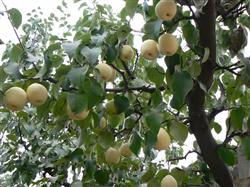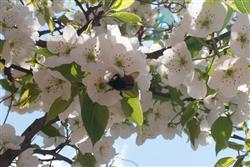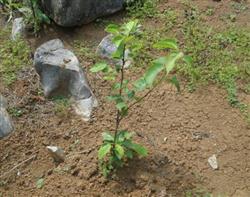How to prune the fruiting period of Yali pear?

How to prune pear trees during fruiting period? Please give guidance to pear tree fruiting period can refer to the following methods for pruning: 1. pruning purpose to keep the tree healthy, adjust the light distribution, so that the tree body ventilation light transmission, branches see light. Continuously renew the branch group to keep the branch group healthy and long. Overcome the big and small year results to ensure high yield and bumper harvest year after year. 2. Pruning principle (1) to reduce instead of sparse, zoom combination. For large branches as far as possible to use the method of retraction, generally not even root thinning. (2) Control is strong, sparse, enlarged and contracted. The upper branch should not be larger than 1/2 of the lower branch. (3) The branch group should be updated in rotation to prevent baldness. (4) Make strips in small years, put strips in big years, adjust the amount of flowers, and prevent fruit in alternate years. Regulate the relationship between growth and fruit, so that the tree body high yield, stable yield, prolong the full fruit period, delay the arrival of senescence. (5) The crown should be small at the top and large at the bottom, sparse outside and dense inside, and the branch group should be complete and compact. The distance between the two main branches reaches about 150 cm. Thinning auxiliary branches between layers is beneficial to the growth of lower inner bore branches and ventilation and light transmission. 3. Pruning methods (1) The large and medium branches are reduced and replaced by thinning, and the combination of heavy reduction and light reduction is combined. The adjacent branches are long and short. For large and medium branches, attention should also be paid to supporting, pulling and lifting, and rational layout. The inter-layer auxiliary branches should be thinned and retracted year by year, and the inter-layer spacing should be opened. (2) For hollow trees with strong upper and weak lower branches, the height of the head should be controlled and the opening angle of the branches should be thinned. Combination of thinning, expansion and contraction. Let the roots grow when the head falls. Thinning branches should be handled by stages, thinning and shrinking the periphery, consolidating the inner bore branch group. The angle of the lower main collateral branches should be properly opened. (3) Combination of scaling and timely renewal, especially the renewal and rejuvenation of the inner branch group. (4) The short fruit branch group (chicken claw branch) should be weak and strong, far away and close, straight and flat. Thinning branches and broken flower buds combine, there are sparse and broken. Sparse branches combined with ring cut. In normal years, the thinning amount should be 20%~30%, 20%~30%, 25% and 25% respectively, and the thinning amount in bore and 30% respectively. The weak branches that do not form flower buds should be cut off and rejuvenated at the ring mark. (5) Whether in the new year or in the ordinary year, the annual branches should be pruned according to the principle of having empty leaves and no empty leaves. The strong and full chicken claw branches adjacent to the branches should be thinned out in the current year; Weak and thin branches should be left in the current year, and the branches left in the current year should be put out in each year and made in small years. (6) Size adjustment shearing method. Adjust the size of the year to start from a small year, as much as possible to keep flowers, and pay attention to making strips. Small years to make, that is, small years more than cut annual branches, long branches in the year, to change the strip, reduce the number of flower buds in the year. Annual release, that is, annual branch long release not cut, promote the formation of a string of flowers, in order to increase the amount of flowers in small years. More flower buds in big year, reasonable load, more broken flower buds, flower for flower, ensure enough flower buds in small year. Thinning flowers and fruits, ensuring reasonable load, high yield, stable yield and high quality year after year. (7) Distribution and pruning of fruit branches of the whole tree According to experience, after pruning, the fruit branches of Yali pear in full fruit stage should account for about 1/3 of the total branches, and the number of branches per mu is about 40,000. When pruning, the main trunk, lateral branches and large and middle auxiliary branches of each tree can be regarded as an independent fruit unit, and then the periphery (or upper part), middle part and inner branch (or lower part) of each branch can be divided into three sections. According to the characteristics of Yali pear with apex growth advantage and easy to produce strong outside and weak inside, strong upper part and weak lower part, and easy to form inner bore without branch group after tree aging, the fruit branch distribution and retention of the whole tree can be from outside to inside, from top to bottom: golden tree (30~ 50% of the outer shoots) The outer (or upper) fruit branches of each large branch account for 50% of the total branches, the middle fruit branches account for 30% of the total branches, and the inner bore (or lower) fruit branches account for 20% of the total branches.(outer shoots above 50cm) outer (or upper) 60% of total branches; middle 40%; bore (or lower) 30%; weak trees (outer shoots below 30cm) outer (or upper) 40% of total branches; middle 20%; bore (or lower) 10%. This can not only press the crown of fruit, but also inhibit the advantage of the tip, which is beneficial to the consolidation of the inner bore branch group of fruit trees, so as to achieve high quality, high yield and stable yield year after year. Click for more pear planting technology Click for more fruit planting technology
- Prev

What medicine should be given before crisp pears blossom?
What medicine should be given before crisp pears blossom? Please introduce in detail how to spray 5 Bomedo stone sulfur mixture before spring germination to eradicate overwintering diseases and pests. For trees infected with rot and black shank, smear the original solution of 843 rehabilitation agent after scraping the disease spot. For leaf pests such as pear aphid, pear planthopper and aphid weevil, they can be sprayed at a speed of 20% after germination to falling flowers.
- Next

How to plant pear trees?
How to plant pear trees? Please introduce in detail that the pear tree has strong adaptability to the natural environment, strong resistance to waterlogging and stress, and can be planted in mountainous and flat land. Pollination trees are needed when planting. For example, yellow flowers match the new century or Hangqing. 1. Pear trees are generally planted from late November to January next year, and should not exceed early spring at the latest.
Related
- Moge, come on! The staff of the peasant association in the producing area of cantaloupe were frightened when the crowd gathered.
- Causes and Solutions of low Fruit setting rate of Apple
- Symptoms and control measures of passion fruit virus disease
- Fruit growing lesson: how do apple orchards keep high yields?
- Can you build orchards in the mountains? What are the pros and cons?
- How to manage the coloring period of Crisson grape?
- This paper introduces the processing technology of two kinds of fig products.
- How much is a month for retired teachers in rural areas by 2020?
- How can strawberry planting increase sugar content? We should pay attention to management in many aspects.
- What are the cultivation techniques on how to improve the yield of golden fruit?

